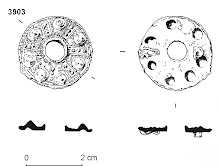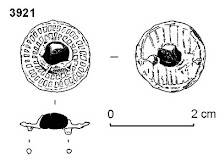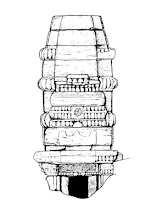'But now of later time
the same ditch is inclosed, and the banks thereof let out for garden-plots,
carpenter's yards, bowling alleys, and divers houses thereon built, whereby the
city wall is hidden, the ditch filled up, a small channel left, and that very
shallow.'
At 100 Minories we will be excavating the City ditch which
surrounded the City of London. A wall and ditch was built around the landward
sides of the Roman settlement of Londinium around 200 AD, and along the Thames from
c 280 AD. Following the re-occupation
of London by King Alfred in 886 AD the walls and ditch resumed their defensive
function and there is evidence for the continued repair, rebuilding and
strengthening of the City wall and bastions throughout the medieval period. In
addition archaeological excavations have shown that the City ditch was repeatedly cleaned
out and recut.
Whilst the walls and ditch were maintained throughout the medieval period, by the end of the Tudor period there were increasing encroachments onto the City ditch, and the whole area immediately outside the City walls was in the process of being built up and becoming a new suburb.
A valuable source for London archaeologists is John Stow's 'Survey
of London', originally published in 1598 and containing historical information
on the history of London, as well as personal observations from Stow's own
lifetime. John Stow was born about 1525 and was a merchant tailor who lived in
the east of the City, he was a keen antiquarian and gathered the information
for his Survey of London over several decades. The Survey describes the situation,
history and main features and customs of London, before describing each Ward in
turn. The book
is available online from British History Online here. Stow died on April
6th 1605 and there is a memorial to him in St Andrew Undershaft and every three
years the quill pen held by his effigy is renewed by the Merchant Tailors in a memorial
service.
 |
| Engraving of John Stow's memorial in St Andrew Undershaft church (image PD-ART) |
Stow describes the City walls in his Survey, referring back
to an earlier chronicler:
'William Fitzstephen,
in the reign of King Henry II, writing of the walls of this city hath these
words: " The wall is high and great, well towered on the north side, with
due distances between the towers. On the south side the city was walled and
towered, but the fishful river of Thames, with his ebbing and flowing, hath
long since subverted them."
Stow first reference is to the digging of a ditch 200 feet wide
around the City between 1211 and 1213, followed by a succession of dates when
the ditch was 'cleansed' or the walls repaired. Clearly there were issues with the
ditch silting up and with rubbish being dumped in it.
Several of Stow's sources refer specifically to the section of
ditch between the Postern Gate (north of the moat of the Tower of London, now
preserved in the Tower Hill underpass) and Aldgate, this is the area in which 100
Minories is sited. In 1354 the City ditch was overflowing into the Tower moat,
and Edward III ordered the ditch cleared out, with in 1519
'cleansing and scouring the common ditch between Aldgate and the
postern next the Tower ditch'
and in 1540
'the same was cleansed, namely the Moor Ditch, and not long before from
the Tower of London to Aldgate'.
In 1569 the ditch was again cleaned between Aldgate and the
Postern and a new 'sewer' and 'wharf of timber from the head of the Postern
into the town ditch' was made, presumably a drain and a timber revetment. Stow
describes how previously:
'Before the which time
the said ditch lay open, without wall or pale, having therein great store of
very good fish, of divers sorts, as many yet living, who have taken and tasted
them, is can well witness: but now no such matter: the charge of cleansing is
spared and great profit made by letting out the banks, with the spoil of the
whole ditch.'
Later in his Survey Stow describes buying, as a boy, milk from the
dairy farm at Goodman's Fields, east of Minories, and vividly sets out the ongoing transition of the Minories area:
'the ditch without the
walls of the city which of old times used to be open, always from time to time
cleansed from filth and mud, as need required; of great breadth, and so deep ,
that divers, watering horses where they thought it shallowest, were drowned, both
horse and man. But now of later time the same ditch is inclosed, and the banks
thereof let out for garden-plots, carpenter's yards, bowling alleys, and divers
houses thereon built, whereby the city wall is hidden, the ditch filled up, a
small channel left, and that very shallow.'
Whether we will be able to archaeologically identify
individual 'cleansings' of the ditch remains to be seen, however Stow does
provide a framework for the management of the ditch, and the evolution of the
area to the east, that will help set the archaeological evidence in its wider
context. His Survey is a plainly written, yet very evocative description of
London, and the period of his life corresponds to the development of the 100
Minories area, and the creation of the new suburb. Stow's mixing of personal
observation and recollection juxtaposes with his historical sources and is a
wonderful source on Elizabethan London and its life.














No comments:
Post a Comment